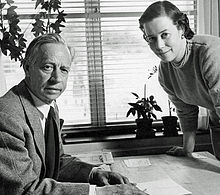Erik Bryggman
| Alvar Aalto | |
|---|---|

Erik and Carin Bryggman in the 1950s
|
|
| Born |
Erik Bryggman 7 February 1891 Turku, Finland |
| Died | 21 December 1955 (aged 64) Turku, Finland |
| Nationality | Finnish |
| Occupation | Architect |
| Spouse(s) | Agda Grönberg |
| Children | 3 |
| Awards | Finnish Association of Architects’ silver plaque |
| Buildings | Resurrection Chapel Atrium apartment building Restoration of Turku Castle |
| Projects | Varberg Crematorium, Sweden |
| Design | Turku Fair |
Erik William Bryggman (7 February 1891, in Turku – 21 December 1955, in Turku) was a Finnish architect. He was the youngest of five brothers of Johan Ulrik Bryggman (1838–1911) and Wendla Gustava Bryggman (née Nordström) (1852–1903). He began studies in architecture at Helsinki University of Technology in 1910 and qualifying as an architect in 1916. In 1914 he and fellow student Hilding Ekelund made a study trip to Denmark and Sweden. In 1920 he travelled to Italy, where he became inspired more by the local vernacular architecture than the classical or Baroque works. He worked in Helsinki for various architects, including Sigurd Frosterus, Armas Lindgren, Otto-Iivari Meurman and Valter Jung before starting his own office in Turku in 1923. Bryggman's architecture is noted for its combination of Nordic, classical and modernist characteristics.
Bryggman married Agda Grönberg (1890–1960), a nurse from Turku, in 1917. Their first child died. Their second child, Carin Bryggman (1920-1993), followed in her father's footsteps, becoming a well-known designer and completing a number of his works after his death in 1955. They also had a third child, Johan Ulric Bryggman (1925-1994).
Bryggman came to prominence in Finland in the early 1920s with his houses designed in the Nordic Classicism style. Among his most notable works from that period are in central Turku, in particular the Hotel Seurahuone (1927-28), the Atrium apartment building (1925-27) and immediately opposite it the Hospits Betel Hotel (1926-29), between which Bryggman designed a small-scale yet monumental flight of stairs and piazza. The Hospits Betel Hotel project is also notable for marking Bryggman's transition from Nordic Classicism to modernism, as during the middle of the project he removed classical decoration and added a distinct modernist campanile adjoining an existing church that was part of the commission.
In 1927 Bryggman started to collaborate with architect Alvar Aalto, and together they became pioneers in Finland in modernist architecture. Their best-known joint project is the design for the Turku Fair of 1929; it is often said to have anticipated the pure modernism of the of 1930; but in fact, the Turku Fair was on a far smaller scale than the one in – the main architects for which were Gunnar Asplund and Sigurd Lewerentz – and Aalto and Bryggman visited nearby Stockholm, Sweden, during the planning and building stages and took inspiration from it. With their celebration of structure, as well as typography and "street furniture", the influence of Russian Constructivist architecture on both the Stockholm and Turku fairs has also been noted by historians.
...
Wikipedia
